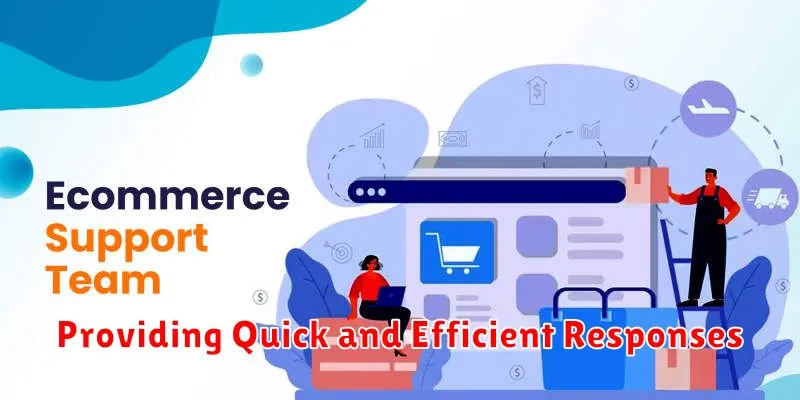In today’s competitive digital landscape, providing exceptional e-commerce customer support is paramount to success. Mastering the art of customer service can significantly impact your business’s bottom line, fostering customer loyalty, driving sales growth, and building a strong brand reputation. This article delves into proven tips and strategies that will help you elevate your e-commerce customer support and achieve significant improvements in customer satisfaction and overall business performance. We’ll explore key aspects of providing seamless customer experiences, from efficient communication channels to proactive problem-solving and personalized interactions.
Whether you’re a seasoned e-commerce entrepreneur or just starting out, this guide provides valuable insights into building a robust customer support system. Learn how to effectively manage customer inquiries, resolve issues promptly, and cultivate positive relationships with your customers. By implementing the tips and strategies outlined in this article, you’ll be well-equipped to navigate the challenges of e-commerce customer support and transform potential customer service pitfalls into opportunities for growth. Mastering e-commerce customer support is no longer a luxury but a necessity in today’s demanding online marketplace. Let’s explore how you can achieve excellence and drive success through outstanding customer service.
The Importance of Excellent Customer Support in E-Commerce
In the competitive landscape of e-commerce, excellent customer support is no longer a luxury, but a necessity. It plays a crucial role in building a loyal customer base and driving business growth. Positive customer experiences foster trust and encourage repeat purchases, contributing directly to increased revenue and profitability.
Effective customer support can significantly impact a business’s bottom line. Addressing customer issues promptly and efficiently can minimize negative reviews and prevent potential customer churn. Furthermore, satisfied customers often become brand advocates, recommending products and services to their networks, leading to organic growth through word-of-mouth marketing.
Beyond immediate sales, strong customer support builds brand reputation and customer loyalty. A positive support interaction can transform a one-time buyer into a long-term customer, creating a sustainable foundation for future success. This reinforces the brand’s image as reliable and customer-focused, setting it apart in a crowded marketplace.
Building a Customer-Centric Support Strategy
A customer-centric support strategy places the customer at the heart of every interaction. This approach prioritizes understanding individual customer needs and tailoring support experiences accordingly. Proactive communication is key, anticipating potential issues and addressing them before they escalate.
Personalization is crucial. Agents should address customers by name and reference past interactions to demonstrate a genuine understanding of their history. This builds rapport and fosters trust.
Empowering support agents to make decisions independently streamlines the support process and avoids lengthy wait times for customers. Providing agents with the necessary tools and authority allows them to resolve issues quickly and efficiently.
Collecting and analyzing customer feedback through surveys and reviews provides valuable insights for continuous improvement. Regularly evaluating and refining your support strategy based on this feedback ensures it remains aligned with evolving customer expectations.
Creating a Seamless Multi-Channel Support System
Today’s customers expect to reach businesses through various channels. A seamless multi-channel support system is crucial for meeting these expectations. This means integrating different communication platforms to provide a unified and consistent customer experience.
Consider incorporating channels like email, live chat, social media messaging, and phone support. Ensure these channels are interconnected. Information gathered through one channel should be accessible through others, preventing customers from repeating their issue multiple times.
A help desk or CRM system can be invaluable for managing multi-channel communications effectively. These systems centralize customer interactions, allowing support agents to access a complete customer history regardless of the chosen communication channel.
Providing Quick and Efficient Responses

In the fast-paced world of e-commerce, speed is paramount. Customers expect quick resolutions to their inquiries. Delayed responses can lead to frustration and ultimately, lost sales. Therefore, implementing strategies for efficient and timely support is crucial.
Prioritize requests based on urgency. Use a ticketing system to organize and categorize incoming inquiries. This allows support agents to address the most pressing issues first.
Utilize canned responses for frequently asked questions. While personalization is important, pre-written templates for common issues can significantly reduce response times. Ensure these responses are adaptable and allow for customization when necessary.
Empower your support team with the knowledge and tools they need to resolve issues efficiently. Comprehensive training and access to relevant information are essential for quick and effective problem-solving.
Set clear expectations with your customers. Provide estimated response times and keep them updated on the progress of their requests. Transparency builds trust and reduces anxiety while waiting for assistance.
Handling Customer Complaints and Returns Effectively
Effective complaint and return management is crucial for maintaining customer satisfaction and loyalty. A streamlined process can transform negative experiences into positive ones.
Establish Clear Return Policies: Ensure your return policy is easily accessible and clearly outlines the process, timelines, and any associated costs. Transparency builds trust and reduces confusion.
Emphasize Empathy and Understanding: When a customer contacts you with a complaint, actively listen and acknowledge their frustration. Empathy can de-escalate tense situations and demonstrate your commitment to resolving the issue.
Offer Multiple Contact Channels: Provide customers with various ways to initiate a return or file a complaint, such as email, phone, or live chat. This flexibility caters to diverse preferences.
Empower Your Support Team: Equip your customer support representatives with the authority to resolve common issues and process returns quickly without excessive managerial oversight. This empowers them to provide timely and efficient solutions.
Analyze Customer Feedback: Regularly review customer feedback related to returns and complaints. Identify recurring issues and implement changes to improve your products, services, and processes.
Utilizing Customer Feedback for Continuous Improvement
Customer feedback is an invaluable resource for enhancing e-commerce support. Actively soliciting and analyzing feedback helps identify areas for improvement and boost customer satisfaction.
Implement various feedback collection methods, including post-purchase surveys, on-site feedback forms, and social media monitoring. Ensure these methods are easily accessible to customers and encourage honest responses.
Categorize feedback to pinpoint recurring issues and trends. This allows you to prioritize areas needing immediate attention. For instance, if numerous customers report difficulties with the checkout process, this signals a need for prompt action.
Use feedback to create actionable steps. Assign teams to address specific issues and track progress. Regularly review the effectiveness of implemented changes and adjust strategies as needed. This continuous improvement cycle ensures your e-commerce support evolves to meet customer needs.
Empowering Your Support Team with the Right Tools and Training
A well-equipped and knowledgeable support team is crucial for e-commerce success. Providing them with the right tools and training is an investment that yields significant returns in customer satisfaction and retention.
Essential tools often include help desk software, live chat applications, and a comprehensive knowledge base. Help desk software streamlines ticket management and allows for efficient tracking and resolution of customer issues. Live chat enables real-time support, addressing customer queries instantly. A robust knowledge base empowers both customers and support agents with readily available information.
Effective training should cover product knowledge, customer service skills, and the use of support tools. Product training ensures agents can confidently answer product-related questions. Customer service training equips agents with the skills to handle various customer interactions professionally and empathetically. Training on the specific support tools enables agents to utilize the technology efficiently, maximizing their productivity.
Measuring and Analyzing Customer Support Performance

Measuring and analyzing customer support performance is crucial for identifying areas of strength and weakness. Key Performance Indicators (KPIs) provide quantifiable data to track progress and make informed decisions.
Some important KPIs to consider include:
- First Response Time: How quickly customers receive an initial response to their inquiries.
- Average Resolution Time: The average time it takes to fully resolve a customer issue.
- Customer Satisfaction Score (CSAT): A measure of how satisfied customers are with the support they received.
- Resolution Rate: The percentage of inquiries resolved on first contact.
Regularly monitoring these KPIs offers valuable insights into the effectiveness of your customer support strategies. Analyzing trends in these metrics can reveal areas needing improvement, enabling you to optimize processes and enhance the overall customer experience.
Leveraging Technology to Enhance the Customer Experience
In today’s competitive e-commerce landscape, leveraging technology is crucial for providing exceptional customer support. Strategic implementation of the right tools can significantly improve customer satisfaction and drive business growth.
Chatbots offer immediate support and can handle frequently asked questions, freeing up human agents to address more complex issues. Integrating chatbots across platforms like your website and social media channels ensures consistent and readily available support.
CRM systems provide valuable customer data that enables personalized interactions. By understanding customer history and preferences, support agents can offer tailored solutions and build stronger relationships.
Self-service portals empower customers to find answers independently through FAQs, knowledge bases, and video tutorials. This reduces the need for direct contact and allows customers to resolve issues at their own pace.
Omnichannel support platforms integrate various communication channels into a unified system. This seamless approach ensures that customers receive consistent support regardless of how they choose to contact your business.

